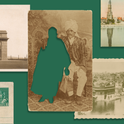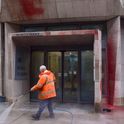US Secretary of State John Kerry (left) recently warned Israel that it risked becoming “an apartheid state” in its treatment of Palestinians. © AP/Getty
In early summer, the Golan Heights are covered with flowers; small scarlet poppies have seeded themselves among the flowering thorn bushes, and in the haze rising from the Sea of Galilee neat orchards of cherry trees are in full leaf. On the high plateau, which Israel seized from Syria in 1967, American tourists examine abandoned artillery posts. But below, the soft crump of shellfire is audible from Arab villages; Syrian fighters supporting the Assad regime in Damascus, just 50 minutes away along a road now choked with gunmen and checkpoints, are firing at rebels, holed up in houses and farms. Neither side is firing at Israel—beyond the occasional shell, apparently accidental—which sometimes meets with fire in return. But the soundtrack of constant violence is a reminder of the turmoil on all sides of Israel in the past three years, “since what we still optimistically call the Arab Spring,” said one British official, adding laconically, “and the Israelis, well, don’t.”
That turmoil is one new concern for Israel. Yet many argue that its most serious threat lies inside its borders, in the perpetual failure of its leaders and their Palestinian counterparts to forge a peace deal. Driving from the Heights back down to the coast, the signs of that deadlock are even more stark at night. Clusters of minarets, glowing with green lights at their peak, mark out the dense, twisting streets of Tulkarm and Qalqilya, Palestinian towns with a particularly militant history; jutting up against them are the slabs of Israel’s new settlements, the target of searing international criticism, their fresh concrete walls lit to a brilliant white by high road lights. Separating the Arab from the Jewish housing are the loops of the eight-metre high barrier wall, built by Israel partly to shield itself from Palestinian suicide bombers; it has become a worldwide symbol of the inability to find a way for the two populations to live peacefully together—or formally apart.
Thomas Friedman, the veteran New York Times columnist, wrote recently that if Israel could not extract itself from the intimate, bitter jigsaw of the West Bank, its future existence as a Jewish, democratic state would be in doubt. But the latest US-brokered attempt, in more than 20 years of sustained effort, has just collapsed—with an almost unprecedented criticism of Israel from Washington. John Kerry, US Secretary of State, warned Israel that it risked becoming “an apartheid state” in its treatment of Palestinians. He later said “if I could rewind the tape I would have chosen a different word,” but he had still given new currency to the comparison with South Africa in the era of white minority rule, a comparison which is vehemently rejected by Israel, but is still proving toxic for its reputation around the world.
It is clear that Israel is “in a real bind,” in the words of one Israeli TV commentator, for at least three new reasons. The first is the demographic point that Friedman makes: the growth of the Arab population within the territory that Israel controls threatens its identity as a Jewish-majority democracy. The second is the rise in international criticism, even in the US, of Israel’s occupation of the Palestinian territories, which is giving Palestinians new success in appealing to the United Nations and other global institutions for recognition and support. Meanwhile, the costs of Israel’s defence of the West Bank settlements are straining an economy that is dazzlingly productive compared to its Arab neighbours but still more vulnerable in the long term than many Israelis would like to believe.
“We are drifting towards disaster,” says one Israeli commentator, of the vision of a future without any peace agreement. “If we go much longer without a deal, it will be horrific for both sides,” said Khalil Shikaki, a respected Palestinian pollster on the West Bank. The best hope may be that this sense of crisis forces new thinking into apparently intransigent quarters. In early June, Prime Minister Benjamin Netanyahu left Knesset members in shock, according to reports, by acknowledging that Israel would have to “separate” from the Palestinians, his use of that word prompting speculation about whether he might even be contemplating a unilateral withdrawal in the absence of a deal.
Nine months of attempted peace talks ended abruptly on 24th April, five days before the deadline set by Kerry. To many, it was a surprise that they started at all. For more than two decades, US presidents and secretaries of state have lined up to throw themselves at the hedge of thorns, convinced that they could hack through the thicket where others had failed. The Oslo Accords of 1993 and 1995; the Wye River Memorandum of 1998; the Camp David summit in 2000; the destinations reached with such effort turned out to be mirages, succeeded by waves of violence and recrimination. “You were the greatest President of all,” said Yasser Arafat, in an oleaginous tribute to President Bill Clinton, who in his last months in office convened the Camp David talks but failed to find agreement between Israeli Prime Minister Ehud Barak and the Palestinian leader. “No,” came the stinging reply from Clinton, according to one story, “but you could have made me that.”
That these latest talks started was down to Kerry, who decided to use the closing passage of President Barack Obama’s second term to have another go. Tall, angular-faced, with an immobile cap of steel grey hair (all assets in Washington politics), and with a career forged in the high seriousness of the Senate Committee on Foreign Relations, “he was born to be Secretary of State,” one commentator said. There had been little sign previously that the Obama administration intended to initiate anything in the Middle East, where its policy was in disarray. In June 2009, in a landmark speech in Cairo, Obama had tried to repair relations with the Arab world after the damage wrought by the US-led invasion of Iraq. But although he sharply criticised Israel for building the West Bank settlements, encroaching on land earmarked for a future Palestinian state, he failed, in Arab eyes, to put real pressure on it to stop. Recently, his actions—or inaction—suggested only extreme unwillingness to get involved in the region, whatever the petitions of close allies; he enraged Saudi Arabia by refusing to bomb the Assad regime, and then appalled Israel by pursuing a deal with Iran over its nuclear programme.
Kerry was driven by “an unfathomable obsession and a messianic feeling,” Moshe Yaalon, Israel’s Defence Minister, was reported in the Israeli press as saying, adding sourly that he hoped that the Secretary of State would “get a Nobel Peace Prize and leave us alone.” After a furious riposte from the State Department Yaalon apologised, but others said—as a compliment—that the gibe was essentially true. “Kerry was magnificent,” said one British official; “he gave them nowhere to hide.” One senior Jordanian figure recounts with approval and amusement that when Mahmoud Abbas, the Palestinian leader, told Kerry that he would have to go back and consult his people—a line that Palestinian delegations had delivered down the years, to be followed with weeks or months of silence—Kerry said “Fine, see you tomorrow.” When Netanyahu said that he couldn’t travel to see him because of a religious holiday, Kerry said “Fine, I’ll come to you.”
Kerry’s conviction, and Obama’s assent to the controversial mission, was inspired partly by a sense of opportunity; the overthrow of the Muslim Brotherhood government in Egypt in July last year weakened the Islamic militants of Hamas, who remain opposed to the existence of Israel and who run the Gaza Strip, one of the two zones of the Palestinian territories. It was prompted, too, by an incredulous frustration—the sense that the broad outlines of a deal over a “two-state solution” of a Palestinian and an Israeli state side-by-side have been clear for 20 years. But above all, there was a sense of alarmed urgency in Washington that these three new factors would make the status quo unsustainable, even if, for some parts of Israeli society, tempting in the short run.
Rockets are still fired from the Gaza Strip towards Israel’s cities—one of the most recent on 11th June, although no one was hurt—and they are reaching further than before. Sitting in Tel Aviv cafes in the warm night air, it is easy to think that things could be worse, if only because they so often been; yet in the end, many in Washington agreed that continuing as things were could be calamitous for Israel itself, as well as explosively intolerable for the Palestinians. “It would not take much for the whole cycle of violence to kick off again,” said one western diplomat.
At the heart of Israel’s new predicament are the blunt demographic trends. According to the Central Bureau of Statistics, the population of Israel at the end of 2012 was just under eight million, of which three-quarters were Jewish, and just over a fifth Arab (mainly Muslim, with some Christian and Druze). But in the whole land controlled by Israel, including the West Bank and Gaza Strip, there are now about 12m people. The Central Bureau of Statistics announced in April 2012 that Jews now constituted a minority in the lands under Israeli rule—5.9m people compared to 6.1m non-Jews—and a minority that is growing smaller, given that the Arab birth rate is higher. Israel faces a stark choice. It can shed the West Bank and retain its Jewish majority. Or it can persist with what is often now called the “one-state reality” or a “bi-national state,” continuing to control the Palestinian territories but undermining its claim to democracy because it does not allow all those people equal civil rights. “Israel cannot remain a democratic state with a Jewish majority by holding on to the West Bank,” wrote the Israel National Security Project, a think tank, last year.
That charge is one reason for the rise in international criticism, the second new factor in Israel’s predicament. That criticism is directed at many aspects of Israel’s occupation of Palestinian territories, but is inflamed above all by the West Bank settlements, new houses and towns built by Israel on Arab land it captured in 1967, which are illegal under international law. Many started just as outposts, but Israel’s government has often encouraged them, offering subsidies to move there, and building roads and power and water supplies, while extending to the settlers the protection of the Israeli Defence Forces. They are off-limits to Palestinians, and so are the access roads knitting them together, giving the map of land accessible to Palestinians the look of Swiss cheese.
Ma’ale Adumim contains about 39,000 people; Ariel, with more than 18,000, extends in a long finger 20km into the West Bank, and the “municipal areas” which they claim extend far beyond the area currently built up. In total, there are now more than half a million Israeli Jews living east of the 1967 lines. The UN estimated in 2012 that there were 325,000 in the West Bank, and in 2011 that there were 192,000 in East Jerusalem; although it has not revised its published estimate, the totals have risen since. While some are there out of conviction that the land historically belongs to the Jews, others find the housing is cheaper, more convenient for work, or they just like it. The daily friction between the populations has constant explosive potential; the Office for the Coordination of Humanitarian Affairs, part of the UN secretariat, reports between around 350 and 400 incidents of settler violence a year against Palestinians, and in 2014, 11 Palestinians have been killed by Israeli Defence Force members in the West Bank.
The expansion of the settlements is the prime reason why Israel’s relations with many other countries are becoming more difficult, as they clearly are. Martin Indyk, Kerry’s envoy to the region, shocked the Israel lobby in May this year when he used a key speech to the pro-Israel Washington Institute to put considerable blame on the role of settlement expansion in the collapse of the peace talks. German leaders since the Second World War have had a sense of intimate commitment to Israel but Chancellor Angela Merkel, who has repeatedly called for a full halt to settlements expansion, said in February in Israel that “we are looking at the settlements issue with grave concern.”
The Israeli settlement of Har Home. More than half a million Israelis live east of the 1967 line. © Baz Ratner/Reuters
In the UK, William Hague, the Foreign Secretary, has made it one of his most prominent themes. In April 2012, he said: “We and our EU partners are clear: systematic, illegal Israeli settlement activity poses the most significant and live threat to the viability of the two-state solution.” In late 2012 when Netanyahu announced his intention to build on E1, a particularly controversial hilltop east of Jerusalem, Hague was on the phone in minutes to Laurent Fabius, his French counterpart, to plan a coordinated response. In Israel in May last year, Hague said that “Israel has lost some of its support in Britain and in other European countries over time—this is something I’ve often pointed out to Israeli leaders—because of settlement activity, which we condemn.” The EU last year published guidelines restricting the issuing of grants, loans or prizes to entities with a presence in occupied Palestinian territories, and in December, UK Trade & Investment, a non-ministerial government department that promotes business abroad, published a warning to companies of the “legal and economic risks” of doing business with settlements, as well as “potential reputational implications.”
The response by Israel to this criticism from other governments has had at least three main strands. First, that every Israeli government since 2000 has signed up to the principle of the two-state solution. Second, that Israel has never had a negotiating counterpart on the Palestinian side who seemed willing and able to deliver adequate recognition of Israel’s right to exist or its need for security—and that people, even political leaders, sitting in other countries, have no conception of what that need feels like in a country so often the target of terrorist attack. According to the Foreign Ministry, 293 Israelis were killed in Palestinian attacks between 2000 and mid-2003, the high point of that wave of violence and before the West Bank barrier was largely in place. The neat plaque on the garden wall of the Cafe de Paris in Jerusalem commemorating the 2002 bombing which killed 11 and wounded 54, or the burned hulk of the Dolphinarium nightclub in Tel Aviv where 21 died in a 2001 attack—these physical reminders hardly do justice, they say, to the sense of threat caused by the assaults on daily life. And even though Prime Minister Ariel Sharon pulled Israeli settlers out of the Gaza Strip in 2005, the continued attacks from there (110 rockets in the first half of 2014, according to Israeli ministries), undermine faith that the West Bank, if released from continued Israeli military control, would not rapidly provide the base for more attacks.
Third, they point out that Israel’s democracy is so energetically representative that the bar for gaining seats in the Knesset is very low; that allows small parties committed to settlement expansion, whether for religious, nationalistic or economic reasons, to hold a coalition hostage. They add that settlements are the subject of intense and growing debate within Israel itself. While some parties favour their expansion, Yair Lapid, Finance Minister and head of the centrist Yesh Atid party within the coalition government, said in early June that “There is no reason to continue to build settlements in areas that will not remain part of Israel in any future agreement [with the Palestinians] or to invest billions in infrastructure that at the end of the day will be given as a present to the Palestinians."
The US and many European governments accept some of these arguments, up to a point; they all repeatedly say that Israel’s security remains paramount, but remain united in censure of the settlement expansion. In any case, whatever traction Israel achieves with these points at the diplomatic level, it appears to be having less success with broader public opinion. There seems to be growing public appetite for the clear labelling of products originating in settlements, worth about £200m of £8.3bn in Israeli exports to the EU in 2011. The “boycott, divestment, sanctions” (BDS) movement is gaining ground, although firmly opposed by many EU governments including the UK and Germany. Driven by NGOs, churches and trades unions, it aims to persuade consumers not to buy products made on the occupied West Bank, companies to withdraw from there, and academics and artists not to perform. Some flatly disagree; Scarlett Johansson, the film actress, announced that she would surrender her role as goodwill ambassador with Oxfam in order to keep endorsing SodaStream, which has a factory in a West Bank settlement. But Vitens, the Dutch water company, cut ties with Israel’s national water company because of settlement concerns, and Romania now demands assurances that construction workers will not work on the West Bank before it sends them there.
Most wounding of all, perhaps, has been the new frequency of the “apartheid” tag; that usage has mainly been in online forums and university campuses, however, hence the shock and fury in Israel when Kerry used it, albeit in a closed-door session. Alan Johnson of Bicom, the Britain Israel Communications and Research Centre, published a recent extensive report attacking the “apartheid smear,” arguing that this comparison with the racial subjugation of South Africa in the days of white minority rule is grotesquely unfair on many counts—all the more as it is directed at “the one democracy in the region.” Simon Schama, the historian, has declared that “the parallel is false.” Despite such ripostes, the label is gaining currency. In this long conflict, fought with words even more than weapons, each side has “killer” phrases it thinks should end the debate altogether once uttered, only to look up bemused as the syllables hurtle by without inflicting lethal harm: “security” and “anti-Semitism” on the Israeli side, and “occupation” on the Palestinian. In adding “apartheid” to this armoury, the Palestinians may have found one that does more damage than most.
Does it matter to Israel what the world thinks? Many Israeli commentators say, not much. “Hague? Who cares? We lost Europe years ago,” is one refrain. That dogged self-sufficiency is admirable in a sense; it springs from the spirit that created the country and defended it against repeated attack. All the same, the cost to Israel of this strain on foreign relations is great. Tzipi Livni, Justice Minister, argued in May that “settlement construction makes it impossible to defend Israel around the world.” Not only is the EU its largest trading partner, but European values should forge a natural bond. Yet the 1970s seem almost unimaginably distant, when leftish students in Britain and other European countries instinctively sided with the brave new country and its socialist ideals, thousands of them flocking to work on an Israeli kibbutz, getting up at 4am to pick fruit with others who had come to live the ideal of the communal life. Now, the left-of-centre support goes almost automatically to the Palestinian side, despite the antipathy that many of these people would surely feel if closely confronted with the mores of many conservative Arab villages.
In the region, too, the cost of the deadlock to Israel is high. It renders unthinkable potentially useful alliances—or at least the quiet acknowledgement of common interests—such as the concern Israel shares with Saudi Arabia over Iran’s nuclear ambitions. And it makes inaccessible the admittedly always remote prize dangled by the 2002 Arab Peace Initiative—formal recognition of Israel by the region in return for a Palestinian deal. This rising criticism has also helped the Palestinians in a tactic of new success: appealing formally to international institutions, and laying the path to apply to them for legal recourse. In September 2011, the Palestinian Authority applied to the UN for recognition as a nation; the bid was approved by the (often anti-US leaning) General Assembly in November 2012, when 138 countries voted in favour, although the US voted against the resolution and the UK abstained. Michael Oren, former Israeli Ambassador to the US, warned in April that “Palestinians turning to UN institutions potentially exposes Israel to massive sanctions and Tel Aviv has to deal with all these threats seriously.”
But in all calculations of the cost, the US matters above all. On the one hand, support in Congress is still rock solid in the Senate and the House of Representatives and in both parties, and it seems unlikely that any presidential candidates for 2016 will be as critical of Israel as Obama. Hillary Clinton, who seems almost certain to run for the Democratic nomination, has veered away from criticism of Israel. On the Republican side, conservative donors have demanded vigorous support for Israel from candidates; superdonor Sheldon Adelson drew an apology from Chris Christie, at a point when he seemed a serious contender for the nomination, for describing the West Bank as the Occupied Territories, although the term is routinely used by the UN. In any case, the affinity of America for Arab causes was never very high, even before 9/11.
The deeper question, however, is whether Obama is not a one off: whether his comparative cool towards Israel is a sign of the future distance the US may come to feel; less engaged, and more inclined to question the cost of the alliance when it becomes high. The US’s exhilaration in its new energy independence after the discovery of shale gas is real; Ehud Barak, when Israel’s Defence Minister, spoke of his fears that this would weaken ties to the region. Sandy Berger, former National Security Advisor, told the Herzliya Conference in Israel in June that US involvement could not be taken for granted. The biggest change may come as the Hispanic share of the US population rises. Maybe those voters, now mainly Catholic, will support Israel as passionately as have the evangelical churches (and the Pope’s recent visit to Israel provoked much comment). But many reckon that they will be less interested than Americans generally have been. In this future, the US would still be loyal to Israel, but an ageing guardian with its own problems and in indefinable ways, further away.
The third new problem is the economy, where the deadlock has added at least some costs, although real cause for alarm about the long-term future is concealed by the present glittering success of the hi-tech sector. “The economy is really two Israels in one,” says Dan Ben-David, a social scientist at the Taub Center For Social Policy Studies in Israel, whose report “The State of the Nation” has provoked heated debates in the Knesset. Hi-tech ingenuity drove exports in 2013 to $61bn (£36bn); as a comparison, the non-oil exports of Saudi Arabia (only 10 per cent of the total) were just $38bn. But that conceals how key indicators are falling behind OECD levels largely because of lack of education and investment in infrastructure. The gap in productivity compared to the OECD (see chart, p28) steals away the prospect of wage rises, and with that, the way to hold on to the brightest.
Ben-David points particularly to the poor education received after age 11 by the children of the ultra-Orthodox community, sent to yeshivas, or religious schools, after that age. The children of Arab-Israeli families have also been poorly educated, although this is improving. That is almost half of the population receiving an education equivalent to that of the third world, he argues. “If we’re heading towards a third world economy in several decades, it can’t support a first world army. And if we’re not able to protect ourselves, we’re finished.” Defence took up a huge 5.7 per cent of the budget in 2012, while the settlements, which cost $17bn to build, cost more to support, notes the Macro Center for Political Economics. Those costs would hardly disappear if a peace deal were reached, of course, nor is the budget deficit of 3.2 per cent of GDP last year a serious concern. But the fear is that if the Knesset does not muster agreement to reverse these longer term trends, the country’s eventual ability to fund its own protection will fall—never mind if a new conflict erupted on its borders.
Given all the new reasons for urgency behind these talks, what went wrong? Many argue that the US was simply too ambitious, trying to make a dash in nine months to clear the obstacles of two decades: the borders, the extent to which Israel would swap tracts of its own land for the right to annex the main settlement blocs; whether Jerusalem would be shared as a capital and if so how; the right of Palestinian refugees to return; Israel’s need for security. But many also say that Kerry made a tactical mistake at the beginning in offering Netanyahu a choice of three goodwill gestures to get the talks underway: releasing around 100 Palestinian prisoners, freezing settlement building, or negotiating on the basis of 1967 borders plus land swaps. Netanyahu chose the prisoner release, which was easier for his coalition to accept than a settlement freeze, but arguably worse in public opinion given the anger towards someof these prisoners for killing Israelis. It also, he later suggested, was an implicit licence to continue announcing more settlement units—13,000 new ones during the period of the talks.
Indyk’s view of the role of those announcements in undermining the talks is shared by many. “Settlement building was the first among equals,” said one western diplomat. But Palestinians undermined trust in turn by signing up to 15 international measures in April before the end of the talks. Abbas “mentally checked out” months before, said one observer; when Israel decided to release the prisoners in batches, he thought “If you [Kerry] can’t give me 30 prisoners, how can you give me Jerusalem?” The talks finally collapsed when Abbas’s Fatah party in Ramallah signed a pact with Hamas in Gaza to form a new unity Palestinian government, albeit composed only of “technocrats,” and Israel, saying that it refused to deal with Hamas, pulled out. “Neither side wanted a deal anything like as much as the US did,” said one observer. “The US has retreated to let them both stew in their own juice,” said another.
For a few weeks, each side was studiedly restrained, Israel not announcing new settlements, and Palestinians not applying to more international bodies for recognition. However, the potential for escalation is clear—and it may have begun. Uri Ariel, the Housing Minister, announced 1,500 more settlement units in June. Abbas is said to have 48 international applications signed and “ready to go, in his drawer.” Each has one explosive card: for Palestinians, it is applying to the International Criminal Court to bring cases against Israel; for Israel, it is building on “E1”. Shikaki, the pollster, points out that some of the applications for international recognition would trigger a cancellation of US and Israeli revenues which support the Palestinian government; without those funds, he predicts, the result could be the third intifada or uprising.
For all that gloom, however, suspended in the bright, dusty air there are flecks of hope. Polls consistently show that a majority of the public on each side still wants a two-state solution. It is helpful that Abbas appears to have persuaded his council of the case for a deal, while Netanyahu himself seems to have shifted position far more than is often credited. Perhaps the greatest reason is that the consciousness of Israel’s growing predicament is prompting many to sketch out ways of edging along a path that lies somewhere between a fully-negotiated two-state solution and the status quo. Those include Ehud Barak, former Prime Minister; Dan Meridor, longtime politician; Michael Oren—influential voices, if not all in the frontline of politics. Some commentators are musing over a unilateral withdrawal, others a retreat to the probable borders set out in a future deal.
It would be grandiose to call this the last chance. As Indyk said recently, “in the Middle East, it’s never over.” It would be extraordinary if a country whose people willed it into modern existence, and which has fought repeatedly for its own survival, irrevocably jeopardised its own future. Israel’s sheer vitality is often invisible to those who deal only with its diplomacy; one columnist said his most-read article ever, worldwide, after a lifetime writing about the peace process, was about what to do in Tel Aviv over a weekend. But there is a sense of a drift towards danger; this is a portrait of a democracy which apparently cannot elect a government that can solve its greatest problems—economic as well as diplomatic— even though a majority of its people repeatedly say that is what they want. As one senior British official put it: “This is barely anymore about who is more right or who is more to blame. The question is where this is going for Israel, as well as the Palestinians, if the years continue to pass and there simply is no deal.”












